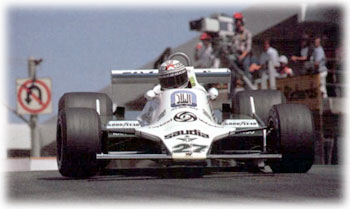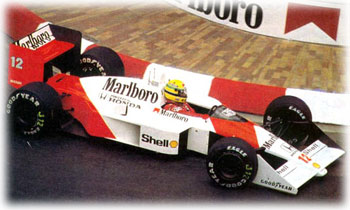The eighties began with a real boom in Formula One racing. A total of 20 racing teams took part in the competition for World Championship points! With this increase in popularity, the FOCA (Formula One Constructors Association), led by Brabham boss Bernie Ecclestone, demanded more starting money. Promoters had to give the FOCA 540,000 US dollars in order to hold one World Championship race. This sum of money was divided up according to the success of each team.
The owners of the teams were in dire need of this financial lift because the general technological race had taken off in earnest. Lap times were reduced by an average of three seconds from the previous year, a result in particular of increased cornering speeds enabled by improved ground-effect technology. Transverse acceleration levels rose to 2.7 g ('g' is the unit representing one's own body weight), measured in the East Corner of the Hockenheimring, which at that time had no chicanes. This rapid development was a cause of alarm for the drivers. Suddenly it had become an effort to brace one's head against the enormous centrifugal force, and it required more and more strength and concentration to keep one's feet on the pedals while cornering.
 At the same time, the constructors began to pay attention to the minutest of details in order to improve their car's aerodynamics. For example, engineer Patrick Head was the first constructor to relocate the petrol pump of Cosworth's "standard engine" to an area at the back of the vehicle which was out of the wind, in order to eradicate unwanted turbulence.
At the same time, the constructors began to pay attention to the minutest of details in order to improve their car's aerodynamics. For example, engineer Patrick Head was the first constructor to relocate the petrol pump of Cosworth's "standard engine" to an area at the back of the vehicle which was out of the wind, in order to eradicate unwanted turbulence.
From a competitive point of view, 1980 was a disaster for the defender of the title, Jody Scheckter. The South African, who one year earlier had become the last Ferrari driver to become World Champion until 21 years later, only managed to collect two World Championship points, leaving him 19th in the final ranking of the Championship. Scheckter's successor as World Champion was the Australian driver Alan Jones.
Before the first World Championship race of 1981, the movable spoilers along the bottom of the sides of the vehicles were banned for reasons of safety. Rigid side spoilers with 60 mm clearance were introduced in order to reduce the ground-effect and with it the cornering speed.
Lotus boss Colin Chapman tried to get around this ban in an ingenious manner: he built the Type 88 with a double chassis. When cornering, the vehicle's soft-sprung primary chassis with rigid side spoilers sealed the gap between the secondary chassis and the asphalt. The project consumed a large proportion of the budget but failed to bring the desired success: officials spotted the trick and forbade the Lotus 88 from entering the competition.
However, the officials came off worse in the end: during the race, when inspectors were unable to measure the clearance, most of the constructions were lowered anyway.
There was one other innovation which was absolutely legal and which was a sign of things to come: McLaren and Lotus became the first to build their monocoques out of carbon fibre instead of the conventional aluminium. The benefits - greater torsional rigidity and increased safety for the driver - were outweighed at first by the weight of the constructions.
1982 began with renewed crafty attempts to bypass the strict regulations. The new fashion was for underweight cars. As it was permitted to refill the cars with cooling fluid in the parc ferme after the race, Brabham and Williams built pseudo-brake coolers into their vehicles. The coolers' tanks were empty during the race, and were then filled up afterwards so as to make up the minimum weight of 580 kg. Nelson Piquet, champion of the previous year, and Keke Rosberg came in first and second at the Brazilian Grand Prix, but were subsequently disqualified. But it was not until a few weeks later that the FIA officially outlawed the cooling water trick.
 The 1982 season would have seen the first win for a turbo driver if the favourite Ferrari duo Gilles Villeneuve and Didier Pironi hadn't fallen victim to serious accidents. The Canadian died at 8th May; the injuries which he suffered when he collided with Jochen Mass's March at Zolder in Belgium ended the life of this "giant", who is still looked on as a hero by many F1 fans. The young driver Riccardo Paletti from the new generation of Italians died only four weeks later in Montreal. Memories of the dangerous years of Formula One were reawakened. However, it was to be another 12 years thereafter before death would befall on a Grand Prix weekend.
The 1982 season would have seen the first win for a turbo driver if the favourite Ferrari duo Gilles Villeneuve and Didier Pironi hadn't fallen victim to serious accidents. The Canadian died at 8th May; the injuries which he suffered when he collided with Jochen Mass's March at Zolder in Belgium ended the life of this "giant", who is still looked on as a hero by many F1 fans. The young driver Riccardo Paletti from the new generation of Italians died only four weeks later in Montreal. Memories of the dangerous years of Formula One were reawakened. However, it was to be another 12 years thereafter before death would befall on a Grand Prix weekend.
After Villeneuve's death, his teammate Didier Pironi was promoted as the favourite for the title. But a serious accident during practice at Hockenheim put an end to the Frenchman's Formula One career. Nonetheless, although he only took part in ten of the sixteen World Championship races that year, Pironi still managed to be runner-up of the 1982 season. The title was won by Finnish Keke Rosberg, and with that he was, for the time being at least, the last induction engine driver to achieve the number one spot. Like Mike Hawthorn, who triumphed in 1958, Rosberg went down in Formula One history by winning only a single race in the year in which he won the title.
The turbo drivers finally assumed control as of 1983 - the HP ratings of their 1.5 litre cc engines having become immeasurably high. By 1986 the engines had far exceeded the 1000 HP mark. Some engine manufacturers were no longer able to quote exact power output ratings because the scales of the instruments on their test beds were insufficient.
The BMW four-cylinder unit which powered Nelson Piquet to victory in 1983 produced 1250 HP with certainty, and optimists even spoke of 1300 and 1400 horsepower! Thanks to this mighty little engine, Gerhard Berger achieved a top speed of 351.220 km/h in his Benetton-BMW when qualifying for the Italian Grand Prix in Monza. Full of respect, the Tiroler later admitted that, at this speed, the track appeared to be getting narrower and narrower with every additional km/h...
 For reasons of safety the FIA introduced pop-off valves the following year, which reduced the boost pressure of the turbos to a maximum of four bar at first. And, as the FIA had declared war on the turbos, the boost pressure was next reduced to an apparently ridiculous 2.5 bar, and in parallel they ruled that only 150 litres of fuel could be used for every Grand Prix.
For reasons of safety the FIA introduced pop-off valves the following year, which reduced the boost pressure of the turbos to a maximum of four bar at first. And, as the FIA had declared war on the turbos, the boost pressure was next reduced to an apparently ridiculous 2.5 bar, and in parallel they ruled that only 150 litres of fuel could be used for every Grand Prix.
The competing 3.5 litre induction engines were not subject to any fuel restrictions, apart from the fact that they too were not allowed to tank up during the race. Because of the extreme handicap against the turbocharger, no driver from this camp was expected to win the Championship from then on.
Niki Lauda (1984) and Alain Prost (1985 and 1986) became Champions driving for McLaren-Porsche. From 1988 onwards, Briton Ron Dennis's team cooperated with Honda, and Ayrton Senna gained his first title. Because of the reduced boost pressure, power output was no longer the main focus of attention. The engines were by now producing around 700 HP during the races. On account of the miserly ration of 150 litres, the risk of running out of fuel before the race was up was enormous.
The teams and oil companies rose to task, specially McLaren and Shell. While coping finely with the thermal difficulties in the combustion chambers, the unleaded fuel provided an extraordinarily good consumption and produced superior power levels too. The reduction of friction losses inside the Honda engines was also of great importance. For this reason, Shell concentrated on an oil whose aim was to make the impossible possible. Their success was decisive.
 McLaren-Honda wrote Formula One history in 1988, when Ayrton Senna and Alain Prost succeeded in winning 15 of the year's 16 World Championship races. And the season's only defeat, at the Italian Grand Prix in Monza, was nothing to do with mechanical reliability either: only a moment of inattentiveness on the part of Senna while lapping prevented the full-season domination from occurring.
McLaren-Honda wrote Formula One history in 1988, when Ayrton Senna and Alain Prost succeeded in winning 15 of the year's 16 World Championship races. And the season's only defeat, at the Italian Grand Prix in Monza, was nothing to do with mechanical reliability either: only a moment of inattentiveness on the part of Senna while lapping prevented the full-season domination from occurring.
In 1989, as the turbo engines were dropped in favour of the 3.5 litre induction units, power output shifted back into the spotlight. The chemical engineers of the oil companies had to rise to this challenge too, and the hour of leaded fuel appeared to have returned. However, Prost secured the title in front of Senna, and Shell was in on the act once again - without having strayed from the unleaded path at all!